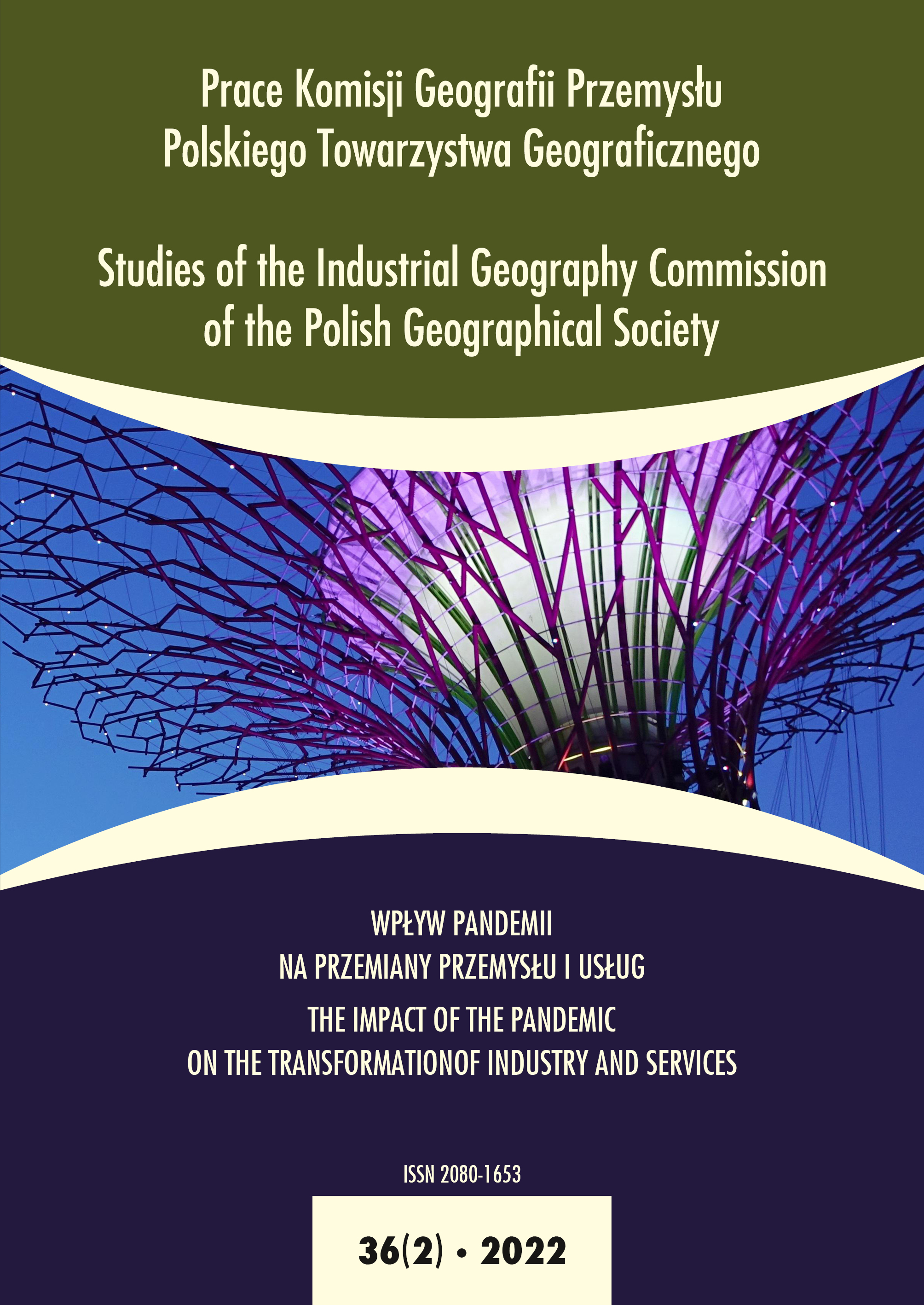Industrial activity and changes in its spatial structure in Poland during the SARS-CoV-2 pandemic
DOI:
https://doi.org/10.24917/20801653.362.3Keywords:
change of spatial structure, industry; Poland; SARS-Cov2 pandemic; spatial differentiation.Abstract
The article deals with the issue of the assessment of industrial activity during the SARS-CoV-2 pandemic in Poland by voivodeship. The aim of the study is to identify the scale of the impact of the SARS-CoV-2 pandemic period in the years 2020-2021 on industrial activity and to determine the consequences in the spatial structure of industry in the system of voivodeships in Poland. The scope of issues adopted for analysis depended on the availability of data, especially at the regional level. The study presents analyses of the basic features characterising industrial activity, i.e. the value of industrial production, the number of employees, the number of entities registered in industrial activity, or the value of the general economic climate indicator in manufacturing. The analyses of the regional structure of industry were complemented by the survey of the survival rate of entities, measured by the number of entities undertaking activities in industry and the number of entities deregistered in the quarters of the analysed period. The results of the conducted research indicate a clear effect of the impact of the first wave of COVID-19 cases (Q2 2020) on the basic parameters of industrial activity. During the pandemic period (Q4 2019 and Q2 2021), the spatial structure of industry in Poland was characterised by high stability, it changed only by less than 3%. Despite high stability, the spatial structure of industrial production was, however, subject to certain fluctuations. The largest changes in the spatial structure of industrial production took place between Q2 2020 and Q2 2019 - 4%. The essential feature of the ongoing structural changes is the relative reduction of disproportions between the distribution of industrial production to individual Polish voivodeships.
Downloads
Metrics
References
Antipova, T. (2020). Coronavirus Pandemic as Black Swan Event. International Conference on Integrated Science. Springer, 356–366.
Bank Danych Lokalnych Głównego Urzędu Statystycznego (2021, 17 listopada). Pozyskano z: https://bdl.stat.gov.pl/BDL/dane/podgrup/temat
Boot, A.W., Carletti, E., Haselmann, R., Kotz, H.H., Krahnen, J.P., Pelizzon, L., Schaefer, S.M. Subrahmanyam, M.G. (2020). The coronavirus and financial stability. SAFE Policy Letter 78.
Czech K., Karpio A., Wielechowski M., Woźniakowski T., Żebrowska‑Suchodolska D. (2020). Polska gospodarka w początkowym okresie pandemii Covid-19. Warszawa: Wydawnictwo SGGW.
Goodell, J.W. (2020). COVID-19 and finance. Agendas for future research. Finance Research Letters, 35, 101512.
Gorzelak G., Jałowiecki B. (1996). Koniunktura gospodarcza i mobilizacja społeczna w gminach ’95. Raport z I etapu badań. Warszawa: EIRRiL.
Hordecka, A. (2017). Polityka gospodarcza w świetle przemian współczesnej myśli ekonomicznej. Perspektywy polityki gospodarczej. Prace i Materiały Instytutu Rozwoju Gospodarczego SGH, 90, 211–238.
Hryniewicz, J. (1998). Wymiary rozwoju gospodarczego gmin. W: G. Gorzelak, B. Jałowiecki (red.), Koniunktura gospodarcza i mobilizacja społeczna w gminach. Warszawa: EIRRiL.
Hudson, R. (2010). Resilient regions in an uncertain world: wishful thinking or practical reality. Cambridge Journal of Regions, Economy and Society. 3(1), 11–25.
Jędrzejowska, K., Wróbel A. (2021). Wielki lockdown i deglobalizacja: wpływ pandemii COVID-19 na gospodarkę światową. W: Rocznik Strategiczny 2020/21. Warszawa: Wydział Nauk Politycznych i Studiów Międzynarodowych UW, 173–198.
Koniunktura w przetwórstwie przemysłowym, budownictwie, handlu i usługach, GUS, Warszawa (2021, 10 listopada). Pozyskano z: https://stat.gov.pl/obszarytematyczne/koniunktura/koniunktura/koniunktura‑w‑przetworstwie‑przemyslowym‑budownictwie‑handlu‑i‑uslugach‑grudzien-2021–roku,3,109.html
Kowalczyk, A., Wilk, W. (1994). Rola sektora prywatnego w gospodarce lokalnej w strefie podmiejskiej Warszawa – na przykładzie gmin łomianki i Zielonka. W: A. Mync, B. Jałowiecki, Przedsiębiorczość i prywatyzacja. Warszawa: Biuletyn KPZK PAN.
McKibbin, W., Fernando, R. (2020). The economic impact of COVID-19. W: R. Baldwin, B. Wederdi Mauro (ed.). Economics in the Time of COVID-19. London: Centre for Economic Policy Research (CEPR), 45–51.
Męcina, J., Potocki, P. (2020). Ekspertyza 11. Wpływ COVID-19 na gospodarkę i rynek pracy w Polsce – wyciąg z raportu badawczego. Warszawa: Katedra Ustroju Pracy i Rynku Pracy, Wydział Nauk Politycznych i Studiów Międzynarodowych Uniwersytetu Warszawskiego.
Nicola, M., Alsafi, Z., Sohrabi, C., Kerwan, A., Al‑Jabir, A., Iosifidis, C., Agha, M., Agha, R. (2020). The socio‑economic implications of the coronavirus pandemic (COVID-19): A review. International Journal of Surgery, 78, 185–193.
Nowak, E. (1990). Metody taksonomiczne w klasyfikacji obiektów społeczno‑ekonomicznych, Warszawa: Wydawnictwo PWE.
Pandenomics. Zestaw narzędzi fiskalnych i monetarnych w dobie kryzysów. (2020). Warszawa: Polski Instytutu Ekonomiczny.
Parysek, J. (1976). Zmiany struktury przestrzennej przemysłu Polski w latach 1960–1973. Próba miernika syntetycznego. Przegląd Geograficzny, XLVIII, 2, 253–268.
Polcyn, J. (2014). Przedsiębiorczość w sektorze publicznym w Polsce na przykładzie rynku edukacyjnego. W: J.D. Mierzejewski, J. Polcyn (red.), Gospodarka w warunkach integracji europejskiej. Poznań: Wydawnictwo Akademii Ekonomicznej w Poznaniu, 157–167.
Polski przemysł w 2020 roku miesiąc po miesiącu. (2021, 17 grudnia). Platforma przemysłu przyszłości. Pozyskano z: https://przemyslprzyszlosci.gov.pl/polski‑przemysl‑w-2020-roku‑miesiac‑po‑miesiacu/
Rachwał, T., Wiedermann K., Kilar W. (2009). Rola przemysłu w gospodarce układów regionalnych Unii Europejskiej. Prace Komisji Geografii Przemysłu Polskiego Towarzystwa Geograficznego, 14, 31–42.
Raczyk, A. (2009). Metody badania przedsiębiorczości oparte na rejestrze podmiotów gospodarki narodowej. Przedsiębiorczość – Edukacja, 5, 133–146.
Szybki Monitoring NBP. Analiza sytuacji sektora przedsiębiorstw. (2021). Warszawa: Departament Analiz Ekonomicznych (2021, 12 grudnia). Pozyskano z: https://www.nbp.pl › raport_3_kw_2021
Sumner, A., Hoy, C., Ortiz‑Juarez, E. (2020). Estimates of the Impact of COVID-19 on Global Poverty. UNU‑WIDER, April, 800–9.
Zioło, Z. (2014). Wpływ kryzysu na kształtowanie struktury przestrzennej przemysłu. Prace Komisji Geografii Przemysłu Polskiego Towarzystwa Geograficznego, 27, 9–37.
Downloads
Published
How to Cite
Issue
Section
License
Copyright (c) 2022 Studies of the Industrial Geography Commission of the Polish Geographical Society

This work is licensed under a Creative Commons Attribution-NoDerivatives 4.0 International License.
Articles are published under the terms of the Creative Commons License (CC BY-ND 4.0; Attribution– NoDerivs).

